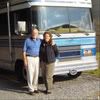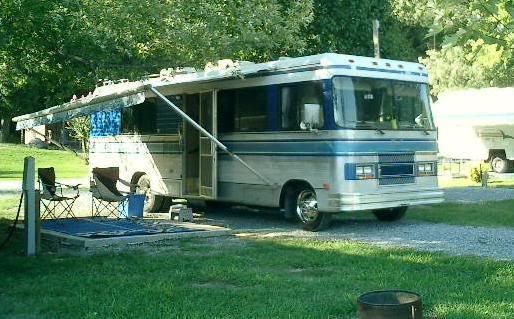Go to...  | Start A New Topic  | Search  | Notify  | Tools  | Reply To This Topic  |  |
 6/12 6/12Formally known as "Humbojb"  |
Hey to Segundo Bill--Wanted to ask you a question. After I had the G/V installed in my 85 28' Regal, I noticed a "gear whine" between 45 and 60 mph. It wasn't very loud but it definately was not there before they installed the G/V unit. It goes away at 60 mph. Have you experience that with your G/V unit? I've talked to G/V about it and they gave me a bunch of double talk about harmonics and other stuff I don't know anything about. I sent them a dummy question about gear whine and they responded by saying "that in some applications, you might experience a slight noise but that it would not be noticeable". Camping World installed it under the supervision of a G/V technician and they're stonewalling me too. The Camping World Service Manager rode with me and confirmed the noise and he said it was coming from the G/V unit but didn't think it was a problem. My original drive shaft was a three piece job with a center support bearing just behind the first short drive shaft and another one behind the center 60" long drive shaft. Now it's a two piece drive shaft, with the front support bearing eliminated. From the back of the transmission, the drive shaft parking brake is mounted and then the G/V unit after that and then the original middle drive shaft. So there's an unsupported distance of around 80" from the back of the original tranny to the rear (and only) support bearing. I spent a lot of money on the G/V unit and wouln't have if I had been told I would have a "gear whine". Does anyone think this is "normal"
| |||||||||||
|
| First Month Member |
I don't know how the GV got into my signature. Anyway, the GV is not presently installed, as I removed it due to a problem with the drum brake on the back. I have not gotten around to reinstalling it yet, as I plan to combine it with a torque convertor upgrade, and have space problems at the moment. But back to the whine. When I installed the GV, the engine noise became less, so I did hear noises from the drivetrain I had not heard before. I don't remember a whine, but by high frequency hearing is shot from the Army and 38 years at LAX. Do you get the whine in OD or direct drive or both? If the driveshaft were to do anything, I would expect it to vibrate rather than whine. How is the rubber mount on the trans? A sagging motor mount can allow metal to metal contact within the mount that is not noticable to the eye. The added weight of the GV might be causing it to settle a little too much. I think I would replace it just to be sure. It's pretty easy. Is any part of the trans or GV touching the chassis? . 84 30T PeeThirty-Something, 502 powered | |||
|
"Host" of Barthmobile.com 1/19 1/19 |
Your not going to like this answer, and I have no way of checking this out for you. What your going to hear is going to scare you. The longer you make a driveshaft, the more likely it will give way to destructive deflection under higher rpm's. That is why a tractor trailer trucks with long wheelbases generally have two or three piece driveshafts with carrier bearings. The only time you can get away with a long driveshaft is if the rig is running at slow speeds. Like in a mining operation. There is a thing called "critical speed", This is where the resonance of a driveshaft will have large magnitude vibration. A driveshaft that reaches this critical speed will "self destruct" and will damage the vehicle, not to mention what it might do to someone that happens to get hit by it! The aftermarket driveshaft maker, must make sure that the driveshaft used will never hit this "critical speed" under any condition. this criticla speed occurs at lower and lower shaft rpm's as you increase it's length or weight. The way it works is, the longer you build a driveshaft the stronger and lighter it should be. An out of balance driveshaft would cause this, a missing weight(like on a tire) would do it, You could even have an improperly installed u-joint. The only thing you yourself can check is the "timing" of the shaft. All yokes should be on the same plain at each driveshaft. Look at each driveshaft and make sure that the whole of the shaft only is looked at. Both yokes should be in the same place at opposite ends. The only ones that suffer from this is where the carriers bearing goes. My gut is telling me that your driveshaft is to long and the angle of the carrier bearing is off. You need proffesional help that no amount of typing is going to give you. Seek out a driveshaft maker in your area and pay them to give you a recommendation. Use that info to beat the gear vendor people over the head with. Take notice, that noise will eventually destroy something in the drivetrain. That noise is a vibration. This is the begining of a cascade event! Here is where I scare the heck out of you... If you loose that driveshaft and it takes out your brake lines you will loose the vast majority of braking as your emergency brake will not help out being attached to the driveshaft prop. I have seen this happen before. Good luck.
| |||||||||||||||
| ||||||||||||||||
It's not the driveshaft. In the '70s GM Turbo400 automatics had an adapter when needed: a flat piece of metal, shaped somewhat like a tuning fork (or a trident), that bolted under two of the transmission pan bolts and extended out to the side. The purpose was to stop a "whine", also known as "harmonic noise", or in GV Doublespeak "harmonics". I had one on a vehicle in 1979. Buy an old-style window crank tool from Pep Boys, drill holes in it, and mount it solidly to the GV case with existing GV bolts/screws. You're not going to get any satisfaction from Camping World/GV, so if it is really an annoyance spend an hour trying this. No, I'm not making this up. This is the same basic thing found on the exhaust system of two of my current vehicles - only they are referred to as "horns", for some reason. Now that I think on it, go to your FLM dealer and get the parts guy to show you a "horn": they are found on F/L/M cars with Hi-Po engines with dual exhaust, and bolt to an exhaust flange on each pipe (sticking out to the side); they serve a different sound purpose on the exhaust but I bet this will work on the Xmiss. Good Luck. "You are what you drive" - Clint Eastwood | ||||
|
| First Month Member |
Bill, a whipping driveshaft could indeed take out the rear brakes, but I believe the front brakes would remain functional. I'm not sure when dual brake master cylinders came out, but it was quite a while ago. . 84 30T PeeThirty-Something, 502 powered | |||
|
| First Month Member |
Gunner, that's really interesting. I would be interested in any more info on that? . 84 30T PeeThirty-Something, 502 powered | |||
|
"Host" of Barthmobile.com 1/19 1/19 |
I know that you would still have front brakes - I have had a system fail and was only able to stop with my front brakes - white knuckle, very scarry - My concern is the bicycle tires in rain or going down hills - although they will be able to slow it down brake fade could happen before they actually get it stopped. If it's raining/snowing they could loose control. You don't want to try and stop with just your front brakes like that. When bleeding brakes down you only crack one of the bleeders loose at a time. Even though it has a dual master cylinder your pedal pretty much goes to the floor. I would think that any front brake only action would be limited
I'm very interested too. Please post here for all to learn.
| |||||||||||||||
| ||||||||||||||||
Captain Doom |
I would think if it were driveshaft deflection, there'd be a vibration; the driveshaft on my LWB diesel van is about that length (I haven't had it out in a few years), but a bad universal was easy to detect due to the vibration under load. And its C6 transmission has a distinctive whine at around 45-50 mph. However, the statement "that in some applications, you might experience a slight noise but that it would not be noticeable" is clear nonsense - how could you "experience a slight noise" if you couldn't notice it? Anyway, as Bill in N.Y. suggests, check to make sure the universal yokes are aligned, and that there's some spline available; if the driveshaft were shortened and not enough play allowed, the driveshaft could be putting pressure on the GV gears or bearings. If you decide to live with the noise, I'd certainly memorialize your concerns in a letter (certified return receipt) to Gear Vendor's Registered Agent. Rusty '94 28' Breakaway: MilSpec AMG 6.5L TD 230HP Nelson and Chester, not-spoiled Golden Retrievers Sometimes I think we're alone in the universe, and sometimes I think we're not. In either case the idea is quite staggering. - Arthur C. Clarke It was a woman who drove me to drink, and I've been searching thirty years to find her and thank her - W. C. Fields | |||
|
| First Month Member |
By coincidence, I drove a car today with a fluid leak in the back. No back brakes. I could chirp the front tires, so the front brakes did not seem to be limited. But the pedal did indeed go pretty far down. I am sure that on a motor home, even with full front braking, it would not stop as well as the car, due to the rearward weight bias of a MH. . 84 30T PeeThirty-Something, 502 powered | |||
|
Captain Doom |
Regarding the driveshaft breaking loose, I recall some trucks in the 60's and 70's that had cages to keep the driveshaft from flopping around, but I don't remember which ones... Rusty '94 28' Breakaway: MilSpec AMG 6.5L TD 230HP Nelson and Chester, not-spoiled Golden Retrievers Sometimes I think we're alone in the universe, and sometimes I think we're not. In either case the idea is quite staggering. - Arthur C. Clarke It was a woman who drove me to drink, and I've been searching thirty years to find her and thank her - W. C. Fields | |||
|
The '79: Corvette, 350/Turbo400 auto: I noticed this flat arm, perhaps 6" in length, sticking out (passenger side) of the transmission housing and asked Chevy Parts Guy what it was: "That's a silencer; your -meaning my specific- transmission will make noise if you take it off." I surmised this was an add-on fix for those automatics which were noisy; I left it alone. I don't recall exactly how it was attached but it didn't come off when I dropped the Xmiss pan to change the Dexron. It was bolted securely/firmly and fit into the side flange, held on by the pan bolts if memory serves. It did, and does, make sense to me, although I am unlearned in Matters Harmonic. Perhaps our resident Canoe U. grad Rusty has experience with vibration noise suppression? "You are what you drive" - Clint Eastwood | ||||
|
 6/12 6/12Formally known as "Humbojb"  |
I can't feel any vibration of the drive shaft at any speed, but the gear whine only occurs between 45 and 55 mph with the G/V unit on,i.e., in 3rd gear overdrive. It goes away completely at 60mph. I'm in "discussion" with both G/V and Camping World, having sent the presidents of both companies a letter that both companies acknowledged receiving. Initial response has not been very encouraging. Nobody seems to think its anything serious but nobody wants to stand behind that statement either.The question is "why would the noise only occur at a certain speed range with the G/V on"? I had absolutely no driveline noise before at any speed in any gear. I'm thinking about Rusty's comment about not enough play in the driveshaft and too much pressure on the G/V unit. But would that explain a noise only at 45/55 mph?
| ||||||||||||
|
gear whine only occurs between 45 and 55 mph That's harmonics. Just as an out-of-balance tire shimmies only at certain speeds,e.g. 55mph or 70mph, the vibration will only occur under certain conditions. Be aware this is an opinion, not knowledge, but consider it. "You are what you drive" - Clint Eastwood | ||||
|
Captain Doom |
I don't think it's necessarily vibration nor harmonics - some gear trains emit a whine at various RPMs, and it's not a serious issue...this one may be, but I don't think it is. Rusty '94 28' Breakaway: MilSpec AMG 6.5L TD 230HP Nelson and Chester, not-spoiled Golden Retrievers Sometimes I think we're alone in the universe, and sometimes I think we're not. In either case the idea is quite staggering. - Arthur C. Clarke It was a woman who drove me to drink, and I've been searching thirty years to find her and thank her - W. C. Fields | |||
|
I'm inclined to go along with the group that says it's not likely to be a major problem. Almost any significant drive train change, and addition of a GV is a major change, is going to change the way things sound. It's easy to get spooked by something unfamiliar. On my 33' Regal SE, from day one, I've had a momentary shudder pulling away from stop. It acts like a bad U-joint, but they all check out perfectly. Most likely there's something in that long drive train that gets momentarily misaligned until everything is evenly stressed and rolling. It hasn't changed in 5K miles, but it still spooks me the first time I pull away. You do have a warranty, and if it gets worse, or is so bad you can't take it any longer, you can always exercise that. There's also the possibility that after those gears get worn in, the noise will diminish. | ||||
|
| Powered by Social Strata | Page 1 2 3 |
| Please Wait. Your request is being processed... |
|
This website is dedicated to the Barth Custom Coach, their owners and those who admire this American made, quality crafted, motor coach.
We are committed to the history, preservation and restoration of the Barth Custom Coach.
We are committed to the history, preservation and restoration of the Barth Custom Coach.



